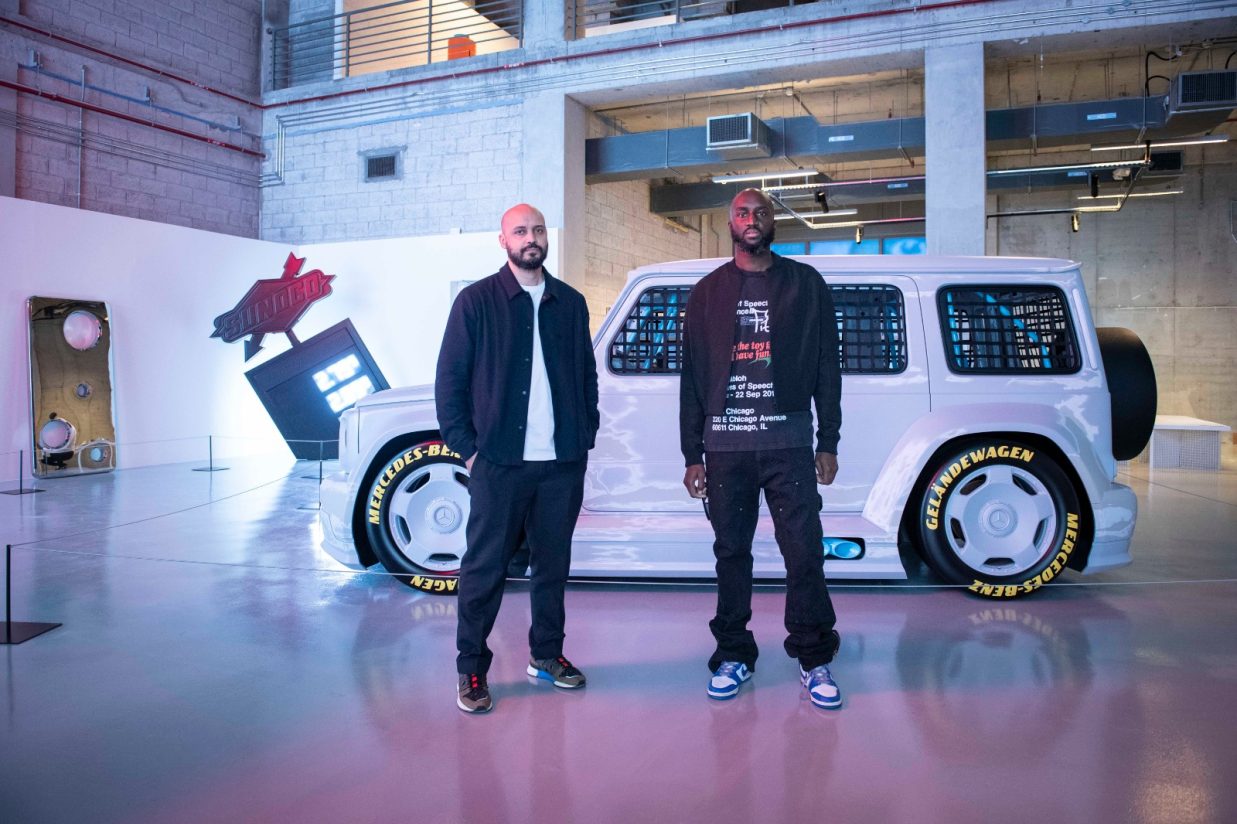The Men behind Figures of Speech
As Figures of Speech, the career retrospective of recently-deceased 41-yeat-old American designer Virgil Abloh, comes to an end in April 2022, we talked to Samir Bantal, director of AMO, who designed the exhibition with Abloh and ask him about the designer and his work.
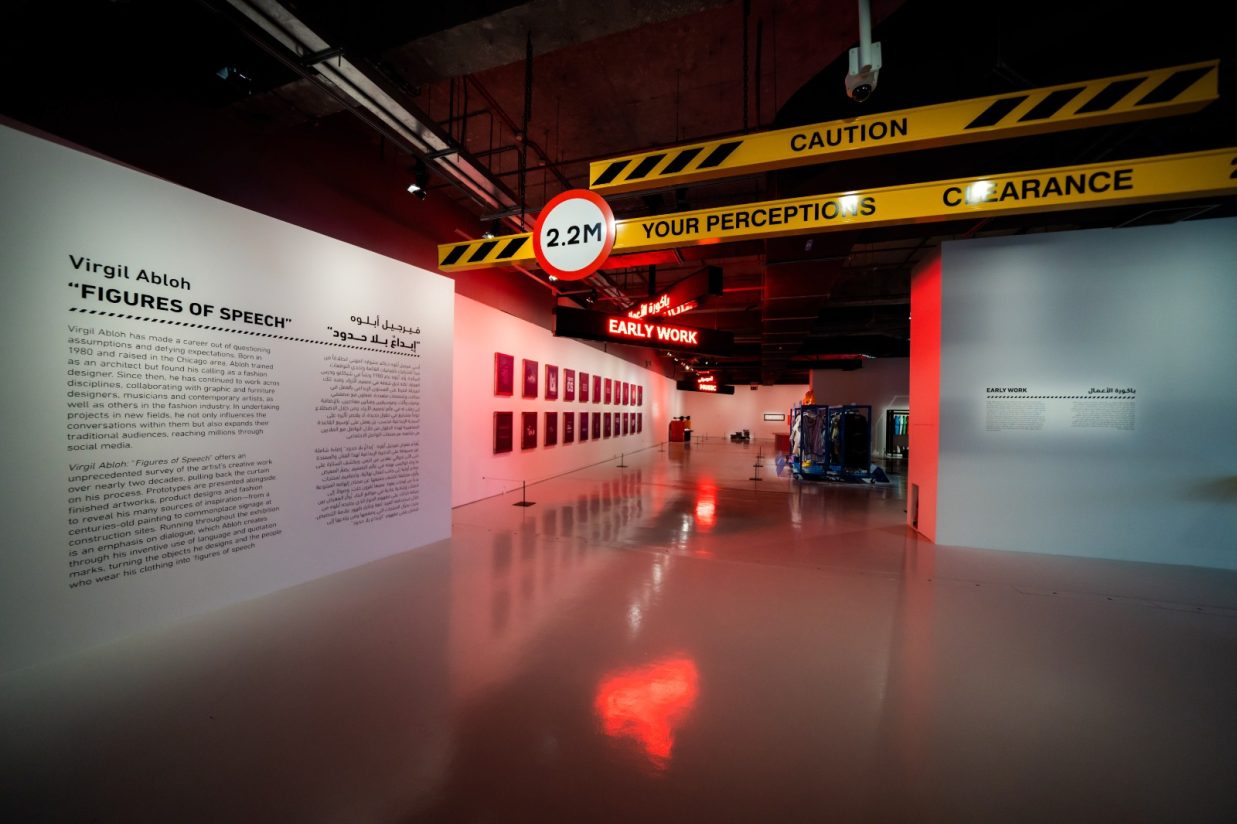 Designers Samir Bantal and Virgil Abloh were in sync, one taking from the other while guiding the press last November through Virgil Abloh: “Figures of Speech”, the American artist and designer’s first museum exhibition in the Middle East. With more than 55 works, curated by Michael Darling in collaboration with the Museum of Contemporary Art, Chicago, and Samir Bantal from AMO/OMA, the exhibition offers an in-depth look at the late artist’s diverse pioneering media practice, from visual arts to music, fashion, architecture, and design.
Designers Samir Bantal and Virgil Abloh were in sync, one taking from the other while guiding the press last November through Virgil Abloh: “Figures of Speech”, the American artist and designer’s first museum exhibition in the Middle East. With more than 55 works, curated by Michael Darling in collaboration with the Museum of Contemporary Art, Chicago, and Samir Bantal from AMO/OMA, the exhibition offers an in-depth look at the late artist’s diverse pioneering media practice, from visual arts to music, fashion, architecture, and design.
In the sudden and shocking passing away of Abloh, an event that the design fraternity described as “unreal”, Bantal called out to Abloh’s tribe and asked them to stay together. “What you ignited, will live on with many,” he assured in his emotional eulogy to the American designer. And stay together they did, from what is evident from the recent Louis Vuitton menswear collection that was shown on January 20, 2022. Abloh’s swan song was described as, “a collection that consolidated the themes most pertinent to Abloh’s time at Vuitton, rooted in experimental practice. Hybridisation was always a central tenet to Abloh’s design practice, and the creations underscored the designer’s belief that “humour is an entry point for humanity”.
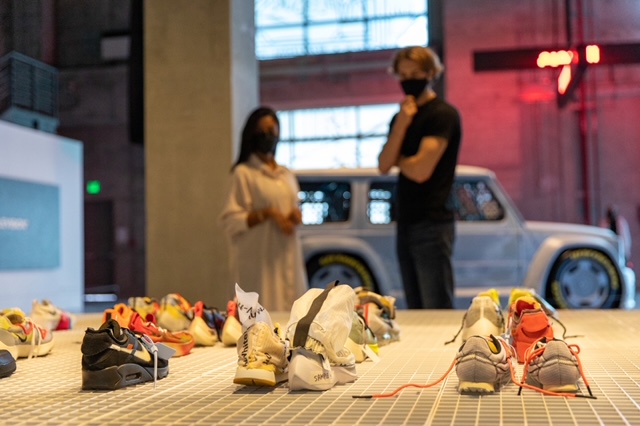 We need to look at Figures of Speech from a different perspective, now that it is a full-career perspective of Abloh, who in his lifetime tried to change perspectives as he defied boundaries of fashion, interiors, and architecture, and influenced an entire generation of youth.
We need to look at Figures of Speech from a different perspective, now that it is a full-career perspective of Abloh, who in his lifetime tried to change perspectives as he defied boundaries of fashion, interiors, and architecture, and influenced an entire generation of youth.
We speak with Bantal to know more about the exhibition, the process of working with the designer, and understanding the genius behind the man.
Figures of Speech was the second exhibition on Abloh’s work, the first one in Chicago curated by Michael Darling in collaboration with the Museum of Contemporary Art, Chicago and AMO, represented by Bantal.
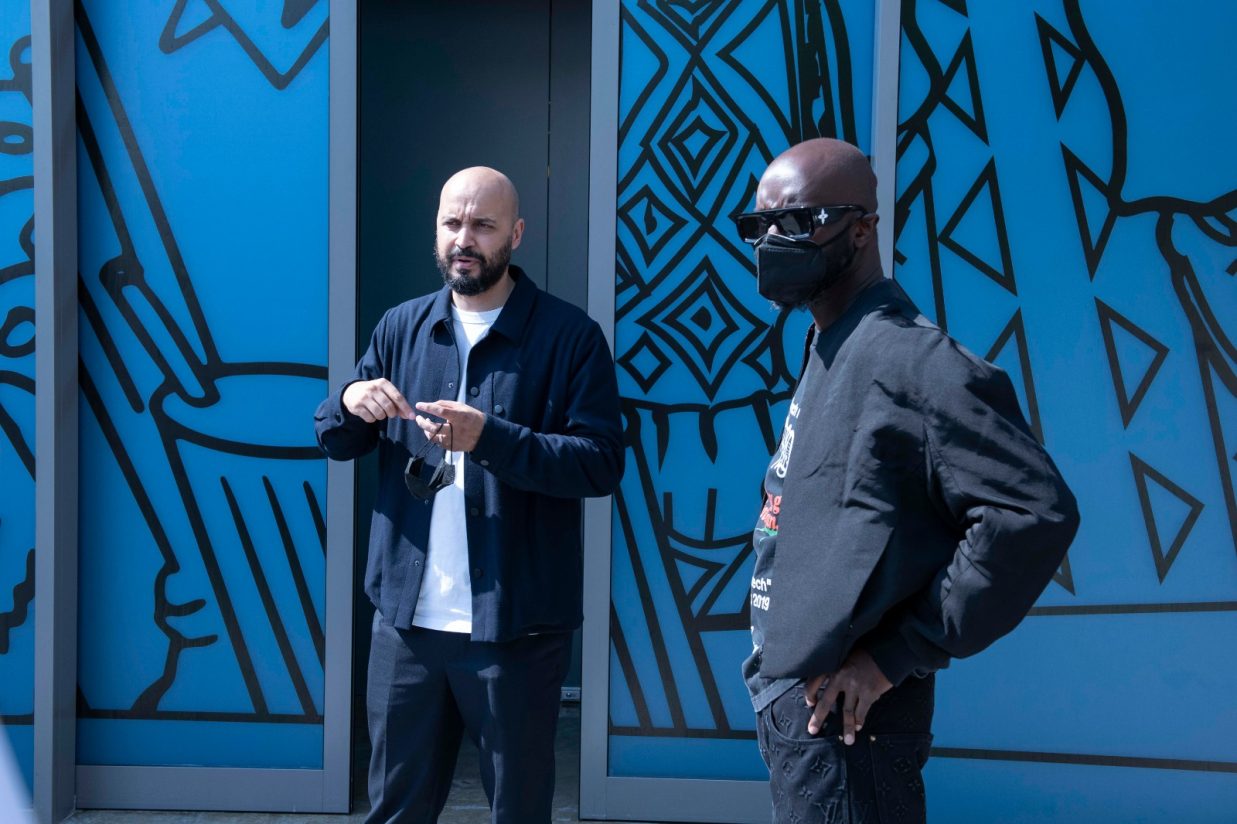 “When Micheal Darling approached Virgil in 2016 with the concept of doing an exhibition, Virgil approached me, asking if I would be interested in doing this as he had no earlier experience of putting together an exhibition while I had done multiple such exhibitions with AMO. We came up with ideas and the concept of the Black Gaze and then built up from to what we see now,” explains Bantal.
“When Micheal Darling approached Virgil in 2016 with the concept of doing an exhibition, Virgil approached me, asking if I would be interested in doing this as he had no earlier experience of putting together an exhibition while I had done multiple such exhibitions with AMO. We came up with ideas and the concept of the Black Gaze and then built up from to what we see now,” explains Bantal.
 Though the space is different and there is a slight relocation of artworks, the exhibition in Doha is almost similar to the one in Chicago with some elements that are new in Doha like the Mercedes Benz G-class concept car called Project Geländewagen and the bouncy castle.
Though the space is different and there is a slight relocation of artworks, the exhibition in Doha is almost similar to the one in Chicago with some elements that are new in Doha like the Mercedes Benz G-class concept car called Project Geländewagen and the bouncy castle.
“It constantly changes and adapts to the local setting but never loses the theme for which it was made,” says Bantal.
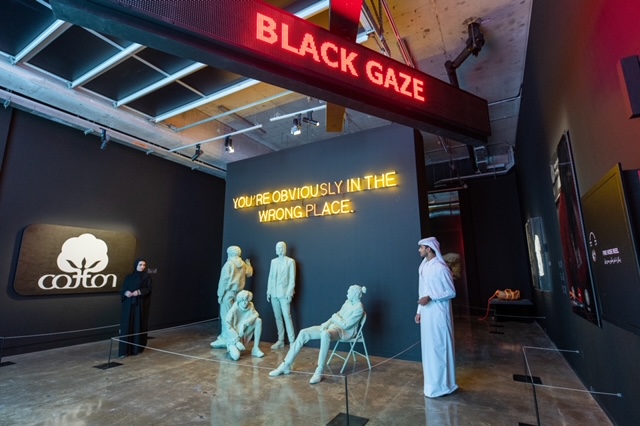 “We went through all the work and looked at how Abloh started as an architect and how he went on to doing music, graphic design, and fashion. We tried to establish the process and identify the most important disciplines for Abloh which was obviously fashion and art then an order appeared on its own and gave itself structure.”
“We went through all the work and looked at how Abloh started as an architect and how he went on to doing music, graphic design, and fashion. We tried to establish the process and identify the most important disciplines for Abloh which was obviously fashion and art then an order appeared on its own and gave itself structure.”
Virgil Abloh had said, “Essential to this exhibition, “Figures of Speech” was for me to approach it with my architectural frame of mind. A particular strain of architecture that Bantal possesses, as the lead of AMO. The dialogue between us early on helped guide not only the exhibit but illustrating what an instance of “architecture” represents today.”
“Moving between fashion, art, design, and music, Virgil has a powerful palette to choose from. Leaning on his architecture training, he creates a potent mixture of these ingredients making his reach in a contemporary popular culture extremely effective,” says Bantal.
Each space within the exhibition touches on different aspects of Abloh’s career: “Early Work,” “Fashion,” “Music,” Intermezzo,” “Black Gaze,” “Design” and “The End.”
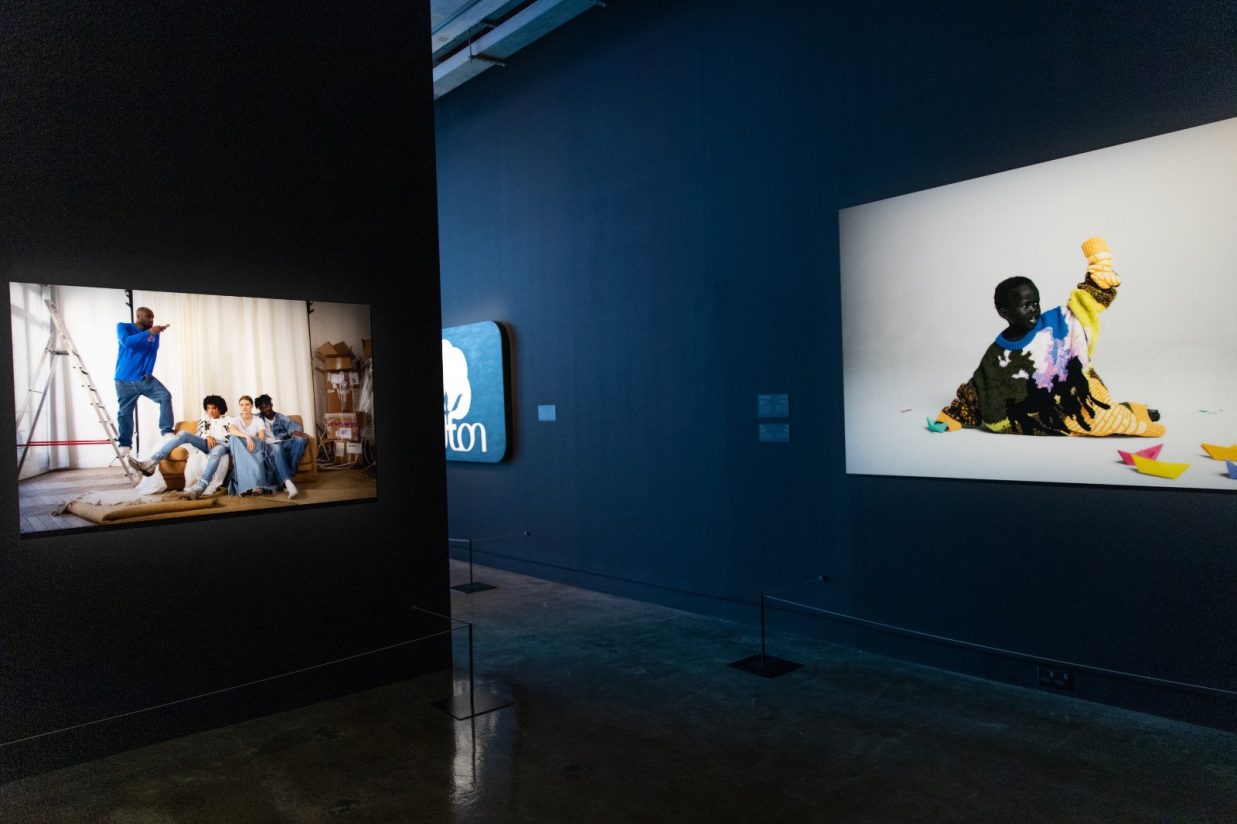 There is subtle humour and an omnipresent critique for the consumer culture present that comes to the fore through the posters created by Abloh. But the designer while appraising the consumer culture is standing within it and looking at it inside out, understanding the layers behind the largely white-dominated areas of fashion.
There is subtle humour and an omnipresent critique for the consumer culture present that comes to the fore through the posters created by Abloh. But the designer while appraising the consumer culture is standing within it and looking at it inside out, understanding the layers behind the largely white-dominated areas of fashion.
“Black Gaze,” one of the more socially-driven installations within Abloh’s exhibit, brings this struggle to life. In this section of the exhibit, Abloh displays some of his collaborations with Louis Vuitton which tackles the exclusion and commodification of black art and fashion in white advertising spaces. In one series of photos, where a black boy poses with colourful Louis Vuitton bags, Abloh seeks to alter the white-centric approach to marketing that he studied growing up as an admirer and consumer of major fashion brands.
“The exhibits for the first retrospective were collected in 2018 before black life matters had become an important social/political issue and through this exhibition, the topics of colonisation, race, and ethnicity were being brought to the fore without having much of a discussion around it. In this space art, architecture and fashion could also have a political dimension and address these topics. Even without making a statement that we could address these issues was revolutionary at this time,” says Bantal.
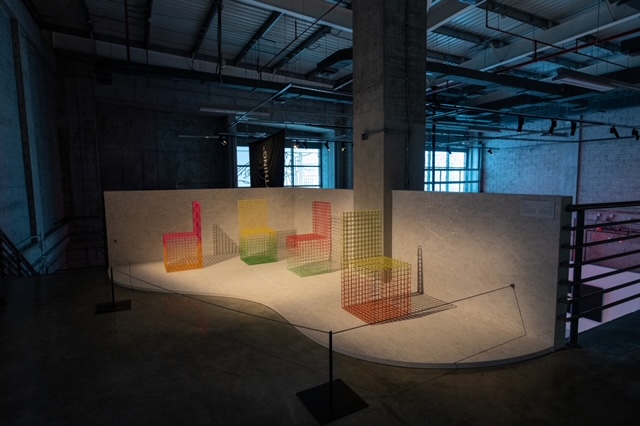 “For Virgil, design was as much about the process as it was about the final product, which he achieved by asking questions and prototyping. Picking apart established norms in the industry, including materials and imagery, he upended expectations to call attention to our surroundings. The transparency inherent in his method nods to his training in architecture and his admiration for the modernist German architect Ludwig Mies van der Rohe, whose buildings make their structures and functions readily apparent,” he explains.
“For Virgil, design was as much about the process as it was about the final product, which he achieved by asking questions and prototyping. Picking apart established norms in the industry, including materials and imagery, he upended expectations to call attention to our surroundings. The transparency inherent in his method nods to his training in architecture and his admiration for the modernist German architect Ludwig Mies van der Rohe, whose buildings make their structures and functions readily apparent,” he explains.
Bantal was also involved in Making Doha, an archival exhibition, recording the history of architecture of Doha, which was revolutionary not just due to the fact that this was a first for the country but also because it was exhibited in a way that gave the process of discovery many layers and depth, adding to the narrative of the built form in Qatar.
“We worked on a non-existent archive of information and hence it was also very creative as we had to source it all and then give it structure. For Figures of Speech, we had an archive of work done by Virgil to dip into,” he says comparing AMO’s two body of works in Doha.
Abloh and Bantal worked through the lens of the ‘tourist’ and the ‘purist’, two types of museum visitors the show speaks to, and have also worked on the Museum shop and products.
On the process of working together with Abloh, Bantal says, “It was like working with a high school friend as if we knew each other for a very long time. We had a lot of ideas in common and it was a great way of working, developing, thinking, deconstructing ones’ own idea of discipline.” And in this vacuum created by the untimely death of this great artist, Bantal writes, “No words can suffice to describe the void you leave behind, no words can express the gratitude and bliss of creating together, across time zones, discipline borders, and conventions.”
Figures of Speech is an ongoing exhibition till April 2, 2022, at the Fire Station Museum and needs to be visited for Abloh’s expansive and democratic views on art and design that commanded attention in his clothes, in retail stores, concert halls, social media feeds, and museums. These themes emerged in his earliest work and established a basis for the projects he continued to create. For Abloh, ‘the end’ is, after all, just a figure of speech, for his work will speak to generations to come.

